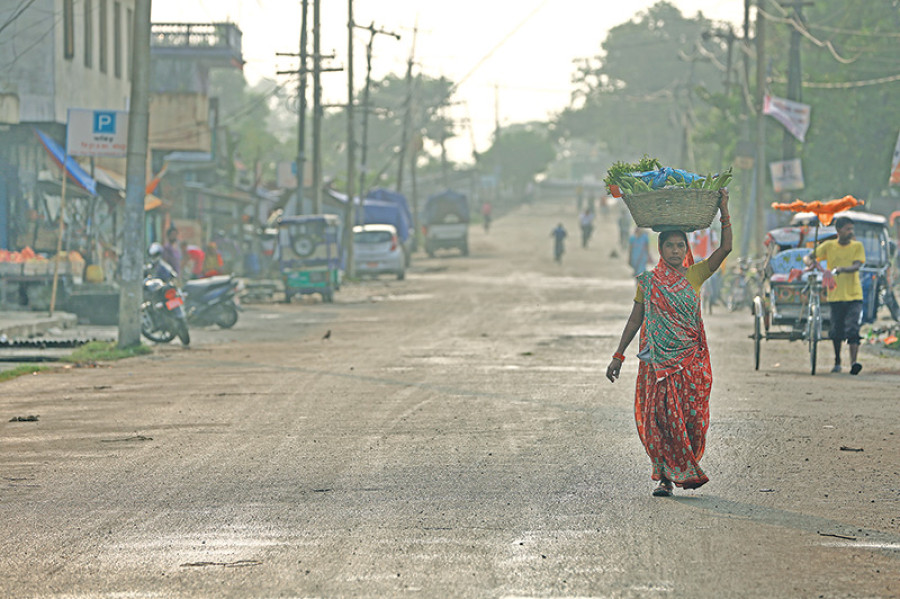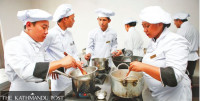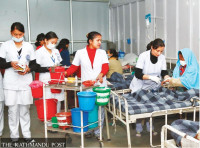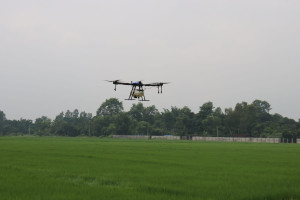Miscellaneous
Hoping against hope
Even a river flows backwards once every twelve years,” says Parbati Rajak, a 41-year-old tea shop operator in Hatkhola, Biratnagar, quoting a Nepali adage on resilience, “So, is there any option but to pick ourselves up and try to restart all over again?”
Milan Poudel
Even a river flows backwards once every twelve years,” says Parbati Rajak, a 41-year-old tea shop operator in Hatkhola, Biratnagar, quoting a Nepali adage on resilience, “So, is there any option but to pick ourselves up and try to restart all over again?”
Having spent the past couple days salvaging and cleaning what last week’s flood spared at her tiny eatery, Rajak is now trying to force a sense of normality back into her life. Her resolve, she admits, springs from the fact that she has lived through a similar flood before. During a comparably harsh monsoon in 1987, when she was 11, the nearby Singhiya River had spilled its banks and inundated her neighbourhood. She still vividly remembers her father carrying her to safer ground on his shoulders, neck deep in water. “Even so, I have never seen the river as angry as it was this week,” she says.
When the rains began beating down incessantly on Sunday, Rajak says that she could sense something was awry—a foreboding that they were in imminent danger. “When the rain showed no sign of letting up, I summoned my two children and other family members, and moved essentials to a safer place—a local theatre house,” she remembers, “Had we not done that, we would have lost so much more.” Within hours, the waters had gushed into the settlement, submerging entire homes.
“Initially, people started panicking, but I maintained my calm. I’ve known this river since I was a child,” Rajak says, “But, eventually I lost my composure too. I have never seen Singhiya so aggressive. Afterwards, I couldn’t sleep for two nights straight. I kept peeking out of the window, checking if the flood was going to sweep us away.”

Now with those fears allayed for the time being, Rajak is busying herself in the kitchen where she is making donuts from scratch. Only a week ago, she had been drawing up to Rs 1,500 a day from her business, but the footfall has since dried up into a trickle. “All my baking supplies were ruined by the water,” she says, “But what is really making it difficult is how the prices have suddenly hiked.” According to Rajak, milk is dearer by five rupees per liter after the flood, as are all other commodities. She has been trying to make up the shortfall by charging her customers an extra five rupees with every order.
Even so, it is hard running an eatery when the entire neighbourhood smells like a cesspool. Despite the fact that residents are busying themselves salvaging what they can to rebuild their homes and lives, the pungent smell of dead and decaying livestock is almost debilitating at Hatkhola.
Nearby, Rabindranath Kamat is busy digging for utensils where his house once stood. Kamat, who works as a peon for a local business, albeit deeply affected by the disaster like many of his neighbours, is still calm and composed. Wearing a pink shirt, drenched with sweat after a morning of rummaging through his house, Kamat appears surprisingly upbeat, even breaking out into a smile while conversing with his neighbour who is supervising the hired help that is helping them dig out their belongings from the mud. “At least, we didn’t lose everything,” he says, “We are still alive.”
Raso Devi Mahato, from Siswani, Morang, too, is counting her blessings. While her home, an hour-and-a-half away on foot, remains submerged in flood water, she felt compelled to make her daily walk to Hatkhola today. “I’ve been sitting in a makeshift shelter for the last five days, there is only so much of that you can do,” she says, as she looks out for potential customers for the basket of vegetables she has hauled down to the bazaar, “At some point, you just need to get moving again.” Before the flood, Mahato had a schedule that ticked like clockwork. Waking up at dawn, she went around her village buying vegetables off her neighbours before making the long walk into town where she made Rs 500 each day, if she was able to sell all her wares. “I’m just so used to it. When I couldn’t do it for five days, I got so fed up,” she says, “So, today, I decided to find what I could and bring it down anyways, even if I don’t end up selling much.”
The flood has caused much damage at Hatkhola. The fear of an epidemic outbreak and the apprehension about surging food prices lingers in the air. The community is still mourning the loss of loved ones and trying to come to terms with all that has transpired this week; hoping against hope that with the lessons learned, sustainable solutions that will ensure that a disaster like this doesn’t happen are formulated. But, there is also a recognition that in order to do so they must first get back on their feet.




 13.12°C Kathmandu
13.12°C Kathmandu










